
The Episcopal Diocese of Washington is a diocese of the Episcopal Church covering Washington, D.C., and nearby counties of Maryland in the United States. With a membership of over 38,000, the diocese is led by the Bishop of Washington, Mariann Budde. It is home to Washington National Cathedral, which is the seat of both the diocesan bishop and the Presiding Bishop of the Episcopal Church.
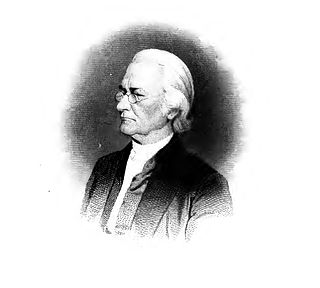
William Meade was an American Episcopal bishop, the third Bishop of Virginia.

St. Michael's Church is a historic Episcopal church at 225 West 99th Street and Amsterdam Avenue on Manhattan's Upper West Side in New York City. The parish was founded on the present site in January 1807, at that time in the rural Bloomingdale District. The present limestone Romanesque building, the third on the site, was built in 1890–91 to designs by Robert W. Gibson and added to the National Register of Historic Places in 1996.

Emmanuel Episcopal Church is an historic Episcopal church located on the west side of U.S. Route 301, just north of the Rappahannock River in Port Conway, Virginia, in the United States. Emmanuel Church and its historic graveyard are located in front of Belle Grove. In 1751, future President James Madison was born at Belle Grove, the childhood home of his mother, Eleanor Rose "Nelly" Conway. On January 7, 1987, Emmanuel Church was added to the National Register of Historic Places.
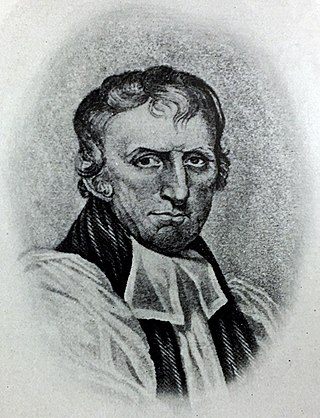
James Kemp was the second bishop of the Diocese of Maryland, US, from 1816 to 1827.
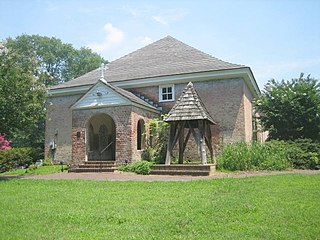
St. John's Church, St. John's Episcopal Church, or St. John's Episcopal Church, Broad Creek, is a historic Episcopal church located at 9801 Livingston Road in Fort Washington, Prince George's County, Maryland. It is a rectangular Flemish bond brick structure with a bell hipped roof. The interior features a barrel vaulted ceiling with an intricate support system.
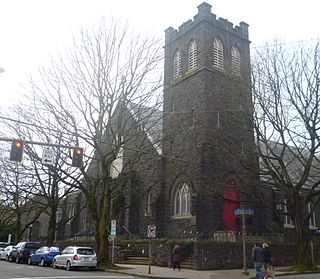
Trinity Episcopal Cathedral in Portland, Oregon is a progressive Episcopal congregation and the seat of the Episcopal Diocese of Oregon of The Episcopal Church. The cathedral is located at 147 NW 19th Avenue in Portland, Oregon, in the Northwest District.
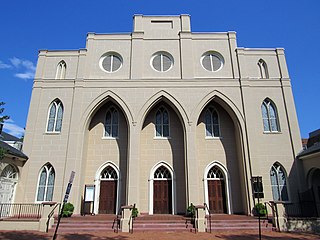
St. Paul's Episcopal Church is an historic Episcopal church in the Anglican Communion located in the Old Town area of Alexandria, Virginia. The church, consecrated in 1818, was designed by Benjamin Latrobe, the second architect of the United States Capitol. It is one of the few buildings designed by Latrobe in a Gothic style and one of the earliest examples of Gothic Revival architecture in the United States. The church was placed on the National Register of Historic Places in 1985. During the year 2009, St. Paul's Episcopal Church celebrated the bicentennial of its founding.

St. Paul's Church is an historic Episcopal church located near the village of Fairlee, southwest of Chestertown, Kent County, Maryland. St. Paul's Church is one of the original thirty parishes created in 1692 by an Act of the General Assembly declaring the Church of England as the established religion of the Province of Maryland. The Georgian-styled building, completed in 1713, is the second-oldest Episcopal church on the Eastern Shore of Maryland.

St. George's Church is an intercultural, multilingual Episcopal congregation in Flushing, Queens, New York City. With members from over twenty different nations of origin, it has served an ever-changing congregation since the 18th century. The current church building, constructed in 1854, is a New York City designated landmark on the National Register of Historic Places.
St. James’ Episcopal Church is an historic Episcopal church located at 2423 SW Bascom Norris Drive in Lake City, Florida. The church is in the Episcopal Diocese of Florida.
John Poyntz Tyler, described "as a great preacher and pastor to people" was the fourth Episcopal Bishop of North Dakota and served from 1914 until weeks before his death.
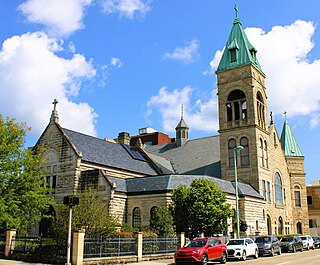
The Basilica of the Co-Cathedral of the Sacred Heart is a cathedral church and a minor basilica located in Charleston, West Virginia, United States. Along with the Cathedral of St. Joseph in Wheeling it is the seat of the Catholic Diocese of Wheeling-Charleston. The parish complex is a contributing property in the Downtown Charleston Historic District on the National Register of Historic Places.

St. Peter's Episcopal Church is a parish of the Episcopal Church in Oxford, Mississippi. It is noted for its historic Gothic Revival church building at 113 S. 9th Street, which once served as the pro-cathedral for what is now the Episcopal Diocese of Mississippi.

Old Chapel is a historic Episcopal church building located near Millwood, Clarke County, Virginia. Old Chapel is now the oldest Episcopal church building still in use west of the Blue Ridge Mountains. It was listed on the National Register of Historic Places in 1973. In 2014, the Chapel Rural Historic District was recognized, and which encompasses both Cunningham parish churches, discussed below, as well as approximately 700 other structures and an area of nearly 10,500 acres.
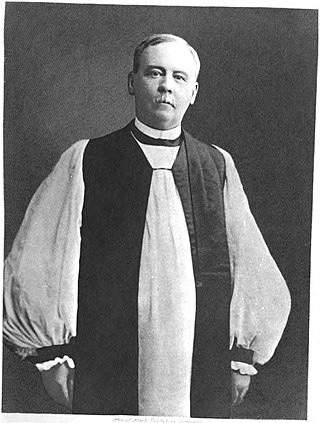
Robert Atkinson Gibson was the sixth Episcopal bishop of Virginia.
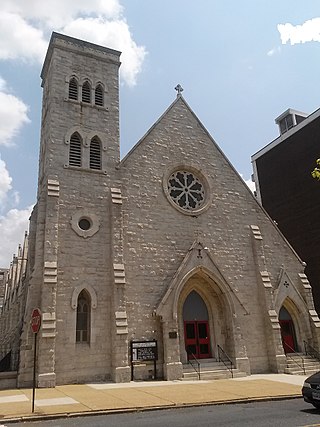
St. James Episcopal Church Lafayette Square, or St. James African Episcopal Church, founded in 1824, is a historic Episcopal church now located at 1024 W. Lafayette Avenue in the Lafayette Square Historic District of Baltimore, Maryland.

St. James's Episcopal Church is the third oldest Episcopal congregation in Richmond, Virginia. Only the older St. John's Episcopal Church on Church Hill also remains an active congregation.

St. Paul's Episcopal Church is an Episcopal parish church located in Evansville, Indiana, within the Episcopal Diocese of Indianapolis. The parish was formally organized in 1836 after a missionary visit from Bishop Jackson Kemper. The present-day church building was erected in 1886 on the corner of 1st and Chestnut St. in downtown Evansville to replace the parish's first church built on the same site. Designed by architects James W. Reid & Merritt J. Reid, the English Gothic Revival-style structure was constructed with Bedford limestone and trimmed with Green River limestone. St. Paul's is known for being the home parish of various prominent figures in Evansville's history. It is also known for its community service, including a weekend soup kitchen through Sr. Joanna's Table.

The Church of Our Saviour at Oatlands is a Reformed Episcopal parish located south of Leesburg, Virginia. Founded in 1871 as a parish of the Episcopal Diocese of Virginia, it met for most of its history in a historic church building on the grounds of the Oatlands plantation. The congregation elected to leave the Episcopal Church during the Anglican realignment and in 2016 relocated to a new building a mile north of the original historic church. It is noted for its use of the 1928 Book of Common Prayer.






















